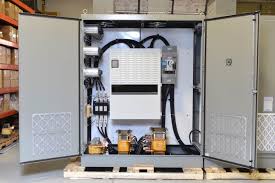Posted on 5th Jul 2024

Choosing the right cables for AC drives is crucial to ensuring reliable operation and maximizing the efficiency of electric motor systems. AC drive cables, also known as VFD (High Frequency Drive) cables or motor drive cables, play a significant role in maintaining signal integrity, minimizing electromagnetic interference (EMI), and protecting equipment from electrical disturbances. Here’s what you need to know about selecting AC drive cables:
Voltage Rating: Ensure the cable's voltage rating matches or exceeds the voltage output of the AC drive to prevent insulation breakdown and ensure safety.
Frequency Compatibility: AC drives operate at variable frequencies. Select cables designed to handle the frequency range of your specific drive to maintain signal quality and reduce losses.
Shielding: Shielded cables are essential for minimizing EMI and preventing interference with other electronic equipment. Choose cables with adequate shielding (such as foil or braid) depending on your application’s EMI sensitivity.
Insulation Material: High-quality insulation materials like XLPE (Cross-Linked Polyethylene) or PVC (Polyvinyl Chloride) ensure durability and protection against electrical faults.
Current Capacity: Consider the current rating of the cable to ensure it can handle the maximum current output of the AC drive without overheating or voltage drops.
Environmental Conditions: Evaluate the operating environment for factors such as temperature extremes, moisture, and exposure to chemicals. Select cables with appropriate jackets (e.g., PVC, PUR) that offer resistance to these conditions.
Motor Supply Cables: These cables connect the AC drive to the electric motor. They need to withstand the inrush currents and varying frequencies generated by the drive.
Control Cables: Used for transmitting control signals between the AC drive and external devices such as sensors, PLCs (Programmable Logic Controllers), and HMI (Human-Machine Interface) systems.
Feedback Cables: In applications requiring feedback signals (e.g., speed or position feedback), these cables ensure accurate transmission of signals between the motor encoder and the drive.
Routing: Keep cables away from sources of electromagnetic interference (e.g., power cables, machinery) to minimize signal degradation.
Bending Radius: Adhere to manufacturer-recommended bending radii to prevent damage to the cables and ensure longevity.
Grounding: Properly ground the AC drive and cable shields to mitigate electrical noise and ensure safety.
Cable Length: Minimize cable lengths where possible to reduce losses and maintain signal integrity.
Choosing the right AC drive cables is critical for maintaining system reliability, minimizing downtime, and optimizing performance. Poor cable selection can lead to issues such as signal distortion, motor overheating, premature equipment failure, and safety hazards. By understanding the specific requirements of your AC drive system and selecting cables accordingly, you can enhance operational efficiency and extend the lifespan of your equipment.
In summary, AC drive cable selection involves careful consideration of voltage ratings, frequency compatibility, shielding, insulation materials, and environmental factors. By adhering to best practices in installation and maintenance, you can ensure that your AC drive system operates smoothly and efficiently, meeting the demands of modern industrial and commercial applications.
According to CM Industry Supply Automation, Investing in high-quality, properly selected AC drive cables not only enhances system performance but also contributes to overall safety and reliability in electric motor systems.